Greek Myths in Art
Greek mythology, with its pantheon of gods, heroes, and monsters, has inspired artists for centuries. The myth of Pandora's Box is a prime example – from the timeless narrative crafted by Zeus to the vivid depictions by French artist Odilon Redon. Redon's portrayal of Pandora, enveloped in vibrant flora yet drawn to the allure of her box, reflects humanity's innate curiosity and its consequences. His work, painted as Europe teetered on the brink of World War I, juxtaposes ancient fable with modern tragedy.
The tale of Perseus and Andromeda, rich with heroism and love, has been brought to life through the masterful strokes of artists like Peter Paul Rubens. Rubens' depiction of Perseus freeing Andromeda captures the epic scale of Greek myths, breathing life into its protagonists and demonstrating the timeless appeal of heroic sagas. This story's transformation into art bridges cultures and centuries, showcasing the universal resonance of Greek mythology.
The Minotaur's legend stands as a powerful symbol of forbidden desire, with artists from Picasso to George Frederic Watts exploring its darker themes. Through Picasso's troubled period marked by his Minotaur obsession, we encounter a blend of personal turmoil and political unease, framed within this mythological context. The Minotaur becomes a vessel for exploring complex emotions, with artists tapping into its rich symbolic potential to mirror societal anxieties.
Contemporary artists continue to draw from the wellspring of Greek mythology. The stories provide fertile ground for artistic expression because they speak to fundamental human experiences: love, betrayal, ambition, and the eternal dance with fate. Reflecting on modern installments like David Medalla's Cosmic Pandora Micro-Box, we see how even ordinary objects can inherit mythic significance, blurring the lines between the sacred and the profane.
Engaging with Greek mythology in art is an exploration of humanity's unending quest for meaning amidst the mysteries of existence. Each reinterpretation, whether on canvas, stone, or through installation, carries forward the timeless themes encapsulated in these myths, proving their enduring relevance in our collective imagination. From ancient amphoras to digital artworks, Greek mythology continues to fascinate and inspire, demonstrating that these ancient stories remain vibrant and compelling in the modern world.
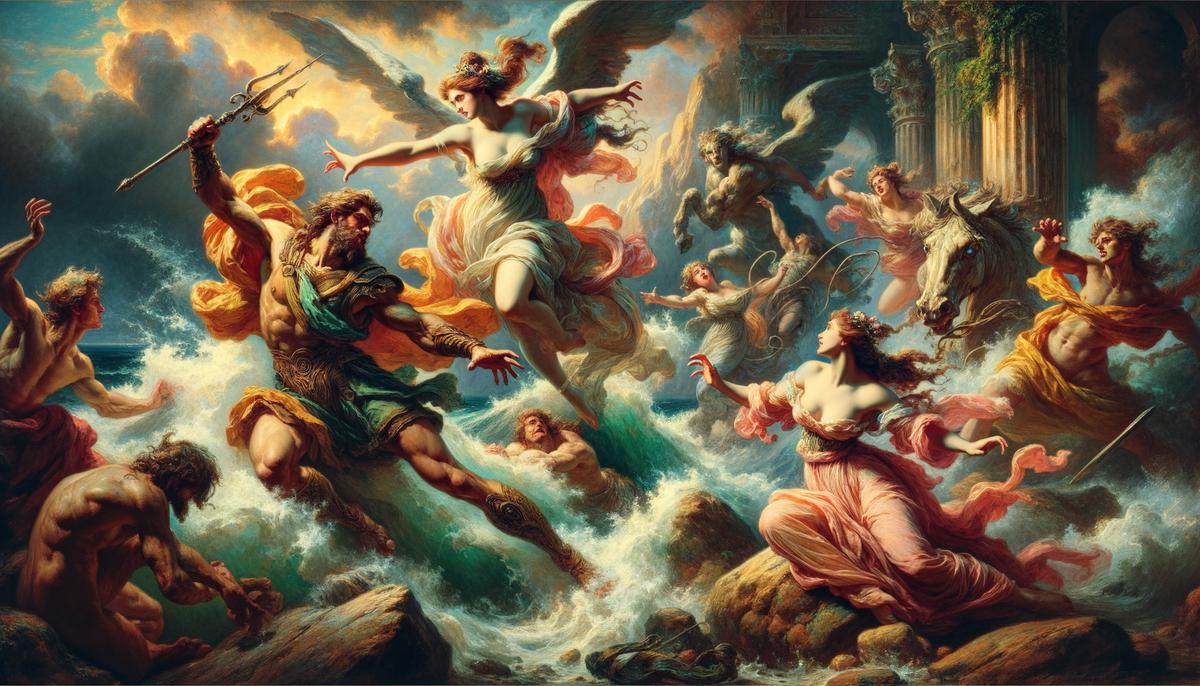
Mythological Symbols in Egyptian Art
The art of ancient Egypt is steeped in symbolism, each brushstroke and chiseled line a testament to a civilization deeply rooted in religious and mythological traditions. Among the pantheon of symbols, the ankh, the Eye of Horus, and the intricately detailed depictions of gods and goddesses on sarcophagi and temple reliefs stand out, serving as profound expressions of Egyptian spiritual life and their conception of the afterlife.
The ankh, with its looped top and T-shaped body, is one of the most recognizable symbols of ancient Egypt. Often held in the hands of gods and goddesses, this emblem is thought to represent eternal life. Its prevalence in Egyptian art underscores the civilization's emphasis on the afterlife and the cyclical journey of existence. The ankh encapsulates a core Egyptian belief: that life is not transient but ever-perpetuating, transcending death itself.
The Eye of Horus functions as both a protective amulet and a symbol of restoration. According to myth, Horus fought Seth to avenge his father's death, resulting in Horus losing an eye to his adversary. This eye was later restored, symbolizing healing and wholeness. Its omnipresence in Egyptian tombs and amulets reflects trust in the eye's protective power against evil and misfortune. The Eye of Horus communicates an intrinsic link between the corporeal and the spiritual, embodying hope for bodily integrity in life and beyond.
Sarcophagi and temple reliefs showcase a variegated assembly of mythological figures, each embodying specific facets of the Egyptian ethos. From the nurturing appearance of Isis to the looming stature of Anubis, these representations served a dual purpose as vehicles for spiritual protection and channels for divine power. Temples adorned with these divine images became sanctified spaces where mortals could convene with the gods, securing blessings and affirming their piety.
Examining such works from various dynasties reveals how Egyptian art evolved to mirror shifting religious sentiments and societal changes. For instance, the New Kingdom era saw a surge in the depiction of the Aten disk following Akhenaten's religious revolution, highlighting a brief shift towards monotheism.1 This period exemplifies how temporal powers influenced the portrayal of mythological motifs, yet the return to traditionalism after Akhenaten's reign illustrates the enduring grip of ancient myths on Egyptian culture.
Egyptian art's rich lexicon of mythological symbols illustrates a civilization intimately connected with its gods and cosmological narratives. From the ankh to the captivating visages of deities on sarcophagi, each symbol served as a nexus between the human and divine realms, guiding the living through life and ensuring safe passage for the dead into eternity. Through such artworks, we perceive not only the Egyptians' artistic prowess but also their profound spiritual insights and quest for transcendence beyond the mortal coil.
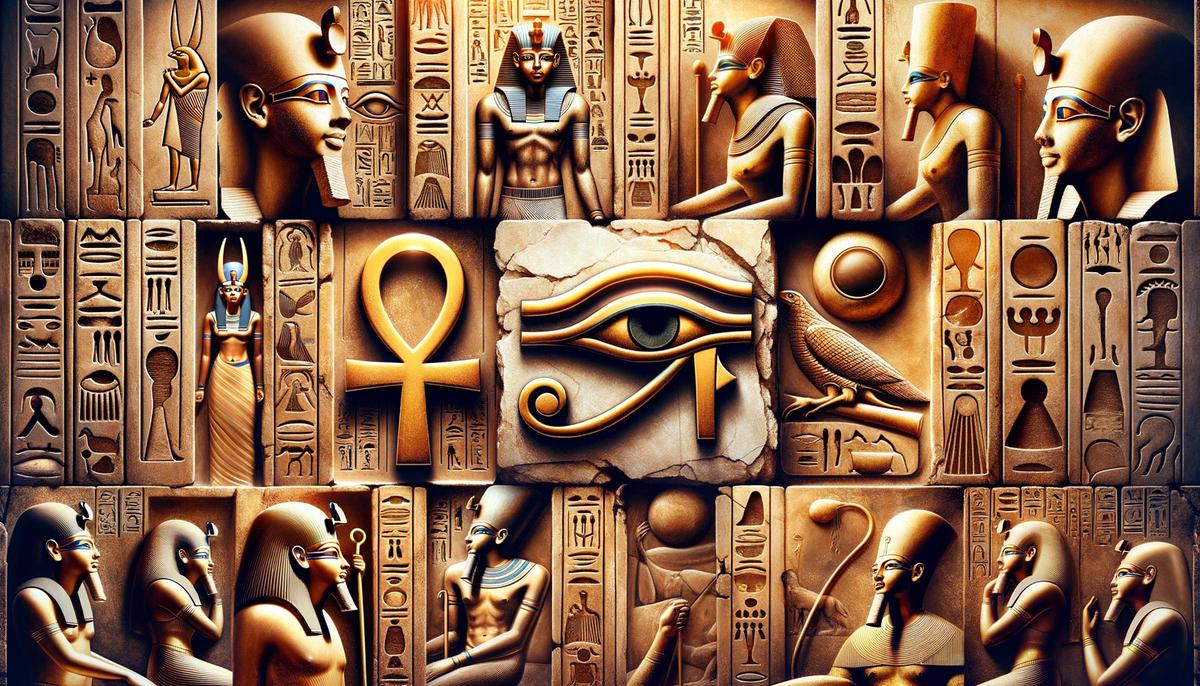
Mesopotamian Art and Myth
The intricate dance between myth and material form in Mesopotamian art offers a captivating glimpse into the spiritual life of one of history's earliest civilizations. Spanning from the Sumerians to the Babylonians, Mesopotamian art richly codifies an entire cosmology, embedding tales of gods, creation, and heroism within sculptures, pottery, and terracotta figures. Among these, the Epic of Gilgamesh stands as a monumental narrative, its themes of friendship, the quest for fame, and the universal search for immortality echoing through centuries.
Sumerian culture laid the foundational stones for Mesopotamian mythological art, with statues of gods and goddesses such as Inanna and Enki embodying the connection between the divine and terrestrial realms. These deities were frequently depicted in a rigid, formal posture, emblematic of their otherworldly nature and their role as overseers of human fate. The conventionalized representation spoke to the profound reverence in which these figures were held; through art, the divine was made manifest, accessible to worshippers and priests alike.
As we transition to the Akkadian period, narratives became paramount in the expression of myth within art. The victorious stele of Naram-Sin, for example, carves out a tale of divine favor and royal triumph over enemies. This shift towards narrative reliefs illustrates an evolving emphasis on storytelling, capturing both divine myths and historical events with equal fervor. These artworks served dual purposes: glorifying leaders and gods while embedding these figures within a comprehensible mytho-historical context.
The Epic of Gilgamesh, perhaps Mesopotamia's most famed literary accomplishment, found its way into various art forms, from cylinder seals to wall reliefs. Gilgamesh's quest to slay monsters and seek out the secret of eternal life mirrors humanity's own existential inquiries. Artistic depictions of his encounters—whether with the wild man Enkidu or the divine Bull of Heaven—mirror the epic's thematic explorations of friendship, the natural world's power, and human limitations. By visualizing these myths, Mesopotamian artists bridged the text's profound ideologies with the tangible, visual culture of their societies.
In Assyria and Babylon, the continuation and expansion of previous artistic traditions reflected the evolving landscape of Mesopotamian politics and theology. The Ishtar Gate of Babylon, resplendent with its images of dragons, lions, and bulls, represents a unification of mythological symbolism with architectural grandeur. Here, the visual depictions act as protectors of the city while proclaiming the power of the Babylonian gods and their king, Nebuchadnezzar II. Such works exemplify how Mesopotamian art transcended mere representation, embodying protective functions and assertions of political dominance through mythological themes.
Mesopotamian art and myth are not silent relics but eloquent testimonies to the intertwined nature of religion, politics, and daily life in ancient Mesopotamia. Sculptures, pottery pieces, and terracotta figures serve not just as aesthetic achievements but as vital conduits to understanding the ethos and beliefs of this cradle of civilization. For researchers, artists, and enthusiasts alike, the study of Mesopotamian art offers invaluable insights into how ancient societies sought to understand their world through myth—casting their hopes, fears, and values in clay, alabaster, and stone.
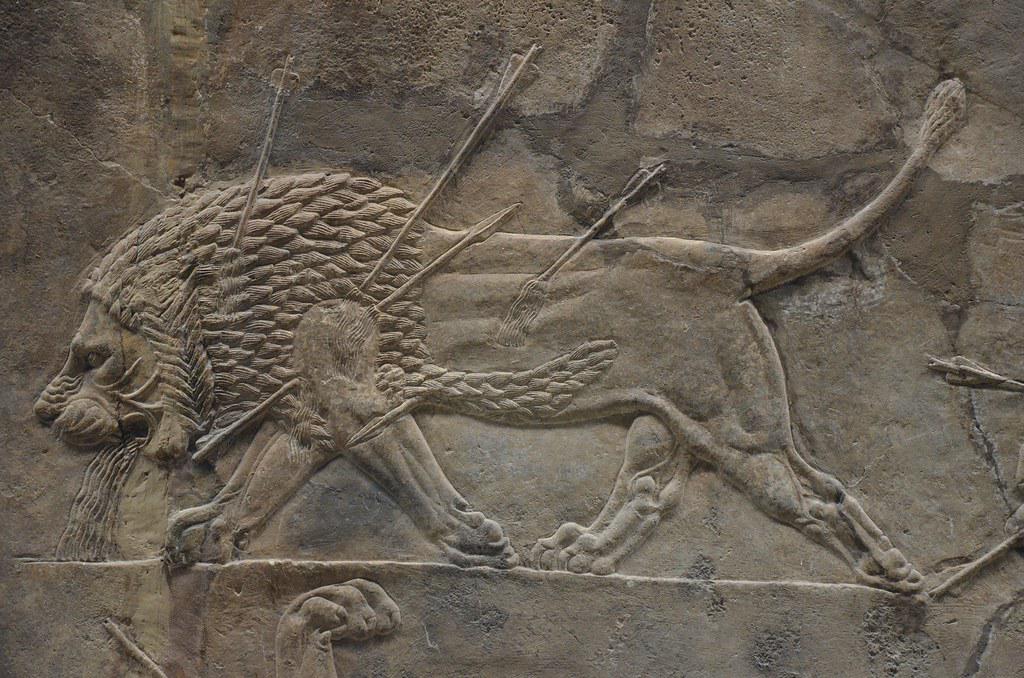
Ancient Art and Modern Interpretations
The reimagining of ancient myths in contemporary art creates a compelling dialogue between the past and present, whereby current creators imbue timeless narratives with new meanings and contexts. This dynamic interplay can be observed across various mediums, manifesting itself in a multitude of forms, from cinematic retellings to novelistic reconstructions and visual art projects. Through these modern interpretations, ancient myths not only persist but also evolve, resonating with contemporary audiences by addressing universal themes from innovative perspectives.
Cinema repackages ancient myths, presenting them with a nuance that often reflects societal concerns and modern sensibilities. Films such as "O Brother, Where Art Thou?" illustrate a creative reworking of Homer's "Odyssey," situating its epic journey within the landscape of the American South during the Great Depression.2 By transposing Odysseus' trials to a starkly different era and setting, the Coen Brothers craft a tale that speaks simultaneously to the endurance of human spirit across ages and the specificities of time and place. This cinematic transmutation underscores the adaptability of ancient narratives and their capacity to offer insights into contemporary life's challenges.
In literature, novelists like Madeline Miller ("Circe") and Natalie Haynes ("A Thousand Ships") have masterfully retold mythological stories from fresh perspectives, often highlighting previously marginalized voices.3,4 Through vivid prose, these writers explore the intricate tapestries of emotions, motivations, and resilience, focusing on characters traditionally sidelined in classical renderings. By doing so, they engage with broader dialogues concerning gender, power, and identity, illustrating how myths can be reworked to reflect and critique current societal norms and values.
The visual arts scene has also witnessed a resurgence of interest in mythological themes, with contemporary artists harnessing the allegorical power of ancient stories to comment on current issues. For example, Yinka Shonibare's "The British Library" interrogates themes of colonialism and identity through the lens of classical mythology, melding historic narratives with the reality of migrant stories.5 These art installations raise pivotal queries:
- What can ancient deities teach us about nationalism, migration, or environmental stewardship in today's world?
- How does the framing of ancient myth illuminate or obscure our understanding of these pressing topics?
Through such reinterpretations, modern artists maintain the essence of original myths — their drama, their poignancy, their caution — while also granting them new life. This renaissance not simply embraces aestheticism but delves into the politicizing potential of these stories, encouraging audiences to reflect critically on their world. This symbiotic relationship enriches both the ancient narratives and contemporary discourse, reinforcing the notion that myths, in their most profound essence, transcend temporal confines.
The reinterpretation of ancient myths within modern artistic expressions underscores a universal affinity for storytelling's ability to navigate the complexities of the human condition. Whether through film's visual odysseys, literature's introspective explorations, or visual arts' evocative installations, the contemporary take on ancient narratives invites reflection, provokes debate, and stirs imagination. These evolved manifestations endure as testimonies to the influence and adaptability of myths — immortal in their essence and endlessly transformative in their impact.
By engaging with these time-honored tales through current themes and dilemmas, artists affirm that mythology remains a vital wellspring for creativity and insight — a bridge connecting past and present with the inevitable flow towards the future.
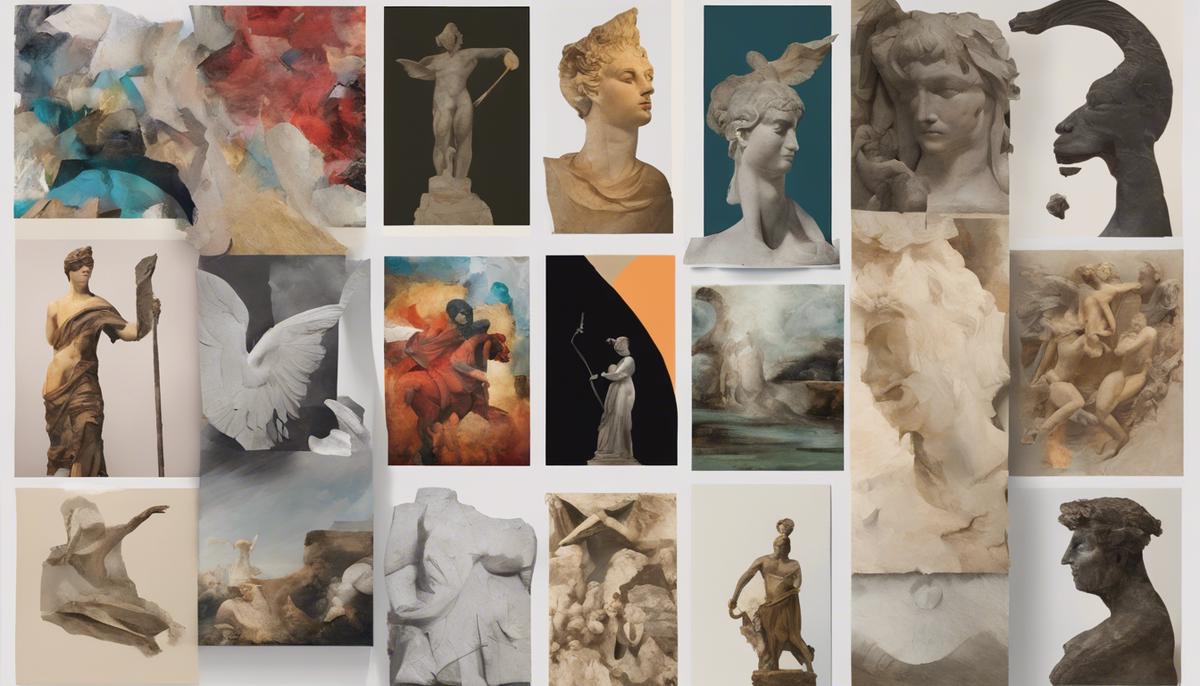
The enduring allure of ancient myths within modern artistic expressions is a powerful reminder of the timeless nature of storytelling and its capacity to illuminate the human condition. By weaving these ancient narratives into contemporary dialogues, artists not only pay homage to our shared heritage but also challenge us to reflect on our present circumstances and future aspirations. This dynamic interplay between past and present, myth and reality enriches our cultural landscape and ensures that these stories continue to inspire, challenge, and guide us across generations.
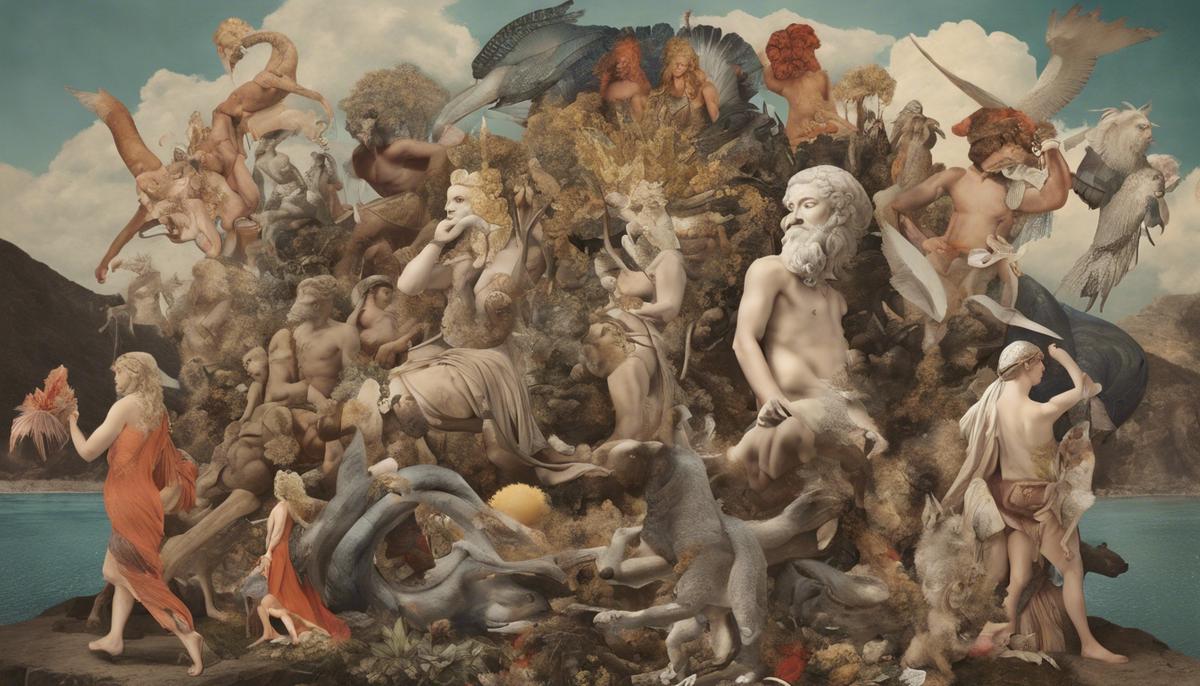
- Hornung E. Akhenaten and the Religion of Light. Cornell University Press; 2001.
- Buchanan L. O Brother, Where Art Thou? Ulysses Mississippi Style. Literature Film Q. 2005;33(4):306-314.
- Miller M. Circe. Little, Brown and Company; 2018.
- Haynes N. A Thousand Ships. Mantle; 2019.
- Johnston N. Yinka Shonibare: The British Library. Contemporary &. Accessed June 14, 2023.























